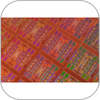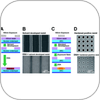TIAN laboratory is currently focused on Micro/Nano Electro Mechanical Systems (MEMS/NEMS). Long-term research aims to investigate the fundamental electrical and mechanical principles of new materials for MEMS/NEMS and low-cost micro/nanomanufacturing approaches, utilizing nanotechnology (“bottom-up” nanomanufaturing techniques, nanomaterials, etc.) to effectively enhance the performance of micro/nanosystems. Present research efforts are the combination of “bottom-up” nano self-assembly and “top-down” hot embossing and other new MEMS fabrication technologies.
Self Assembly
autonomous action by which components organize themselves into patterns or structures [SOURCE: ISO/TS 80004-8 v1, 3.11]
- Colloidal crystallization
- Directed self-assembly (DSA)
- Graphioepitaxy
- Ion beam etch surface reconstruction
- Langmuir-Blodgett
- Langmuir-Blodgett film formation
- Langmuir-Blodgett film transfer
- Self-assembled monolayer (SAM)
- Stranski-Krastanow growth
- Surface functionalization
- Surface migration
- Virus assembly
The Center for Advanced Materials Processing (CAMP) at Clarkson University is dedicated to developing Clarkson's research and educational programs in high-technology materials processing and is focused on industrial concerns and meeting industrial needs. CAMP's mandate is to develop innovations in advanced materials processing and to transfer this technology to business and industry. The Center is built on Clarkson's recognized expertise in colloid and surface science and fine particle technology.
MicroContinuum Inc. was founded in 1998 by a group of former Polaroid scientists and engineers with the goal of developing and commercializing new and innovative roll manufacturing technologies.
MicroContinuum facilities, located in Watertown MA, house an wide range of laboratory and manufacturing equipment, including two roll-to-roll (R2R) micro/nanoembossers, R2R vacuum coater, batch sputter coater, slitter, analytical instrumentation, among others.
Nanofilm was founded in 1985 by Dr. Scott Rickert and Don McClusky. The foundation of the company is Dr. Rickert's pioneering work in self-assembling thin films at Case Western Reserve University where he was a professor and researcher. The company quickly began successful commercialization of nanocoatings and surface preservation treatments.
In two decades the company's technology portfolio has expanded rapidly to include dozens of products in three core technologies: self-assembling nanofilms, nanocomposites, surface preservation and care.
The territory described by KnowmTech's patent portfolio encompasses memory systems, circuits and devices inspired by the biological nervous system.
We assemble structures and chemistries at all length scales on flat, curved, smooth, and uneven surfaces made of a broad range of materials, including metals, polymers, oxides, and ceramics. We assemble these structures and chemistries over small and large areas, and integrate these into practical two- and three-dimensional systems and devices.
ExQor's patented bio-nanotransport platform enables delivery of many different types of drugs throughout the body, including the brain. Uniquely and unlike almost all other nano-particles, ExQor's could also become a powerful new therapeutic in its own right.
ExQor's multiple patents cover Clathrin, a vitally essential protein responsible for transporting a very broad variety of substances—from cholesterol to neurotransmitters—to the interior of cells. Clathrin is also implicated in viral diseases, like HIV.
3DM Inc. is a privately-held specialty biomaterials company, with a mission of developing novel medical therapies through its technologies for accelerating wound healing and tissue regeneration across a range of medical indications.
3DM’s medical devices provide a critical bridge in wound healing and tissue regeneration –a resorbable injectable nano-scale scaffold to accelerate ingrowth of normal local tissue.










